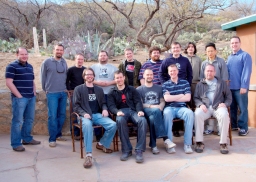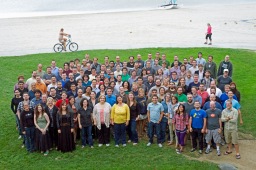I originally drafted this post back in January 2015. Like many of you, I have a ton of posts in drafts that I just never got around to publishing. Having worked at Automattic in the past where we were 100% distributed but with frequent in-person meetups, and an SF office for get togethers — today I often get asked about remote/distributed work and if startups should try it. My short answer is that it depends on the org and stage of the company and that more importantly, it’s a false choice to be 100% distributed or 100% in the office. I’ll explain in more detail below.
I’m a big believer that you need in-person time with colleagues, but certainly, most workers don’t need to be in the office every single hour, every single day. So given the current pandemic forcing many of us to work from home, I went looking for this post. And I feel like post-pandemic this might be the right model. So here goes – my thoughts from over five years ago, with the caveat that things have obviously evolved but most of these ideas I still think are relevant to think about:
January 2015:
Great discussion happening right now about the benefits and downsides to working in an office VS being part of a distributed workforce (aka “remote working”).
The conversation started off with Paul Grahm’s post, and Matt Mullenweg’s response post, plus a ton of chatter on Hacker News.
I actually see arguments for both camps as being pretty solid and think every company needs to decide for itself what works best. My $.02 is that engineering-centric organizations that are very comfortable with async and text-heavy communication tools, will likely have more immediate success than sales heavy organizations. And ultimately it’s an HR challenge, in that distributed workforces need to employ highly independent, motivated, and entrepreneurial folks who don’t need a ton of guidance, and don’t need to be mentored a ton.
But I’d like to make a suggestion for companies who are thinking about this topic. There is no need to be purely distributed, or purely stuck in one office. Go Hybrid!
By Hybrid I mean the following – assume you’ll be in-person for maybe 3 days a week, and the rest of the time your colleagues will work from wherever. For some that will mean a home office, for others a co-working space or a coffee shop.
Specifically:
- Have an office near a big city (and/or a good airport) where people will naturally gravitate to, and you’ll be near your customers and partners.
- For large companies, have multiple offices. I don’t see the need for mega campuses. You can do meetups for workers that need to collaborate in-person occasionally.
- Stop being so rigid on office culture in terms of when people work. Move to being output driven.
- For meertings/video/audio calls and the like – try and keep them between reasonable hours that don’t force early morning or late night commutes. ex: only have meetings between 10am and 3pm.. Consider no meetings on Monday and Friday which are heavy traffic / long commute days, and encourage Mon and Fri to be deep project days, where people can grab 2+ hour long chunks of time to go deep on work. If people only commute 3/week and don’t fight rush our, they may actually get more comfortable living a bit further away in a more affordable housing situation.
- Use the best tools that highly distributed teams use — Slack, Skype, etc – even when you are in the office.
- Document everything! Every meeting should be summarized (Square has been doing this for years), every discussion, every bit of financial and product metrics should be available to all employees.
- Work on a handbook to get new employees ramped up quickly. Automattic did an amazing job with this effort.
- Invest in internal tools. You need a team ideally dedicated to making “work from anywhere” efficient. You need a search tool, you need a way to understand the big goals, the OKRs, and so much more. The more you make your resources self-serve, the better you’ll do in not needing to be in the office every single moment and a huge secondary effect of this is making new hires more efficient and have quicker ramp=ups.
The days of an expensive office, in a big city, where your employees struggle to find nearby affordable housing just doesn’t feel that viable long-term. But the idea of only being distributed with no in-person interactions also feels challenging and deprives us of the energy we need to create and be happy & productive.










You must be logged in to post a comment.